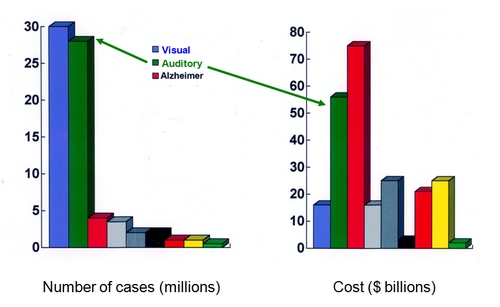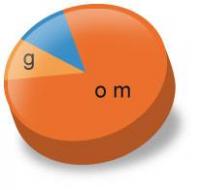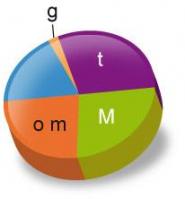Deafness: overview
Authors: Rémy Pujol, Frédéric Venail
Contributors: Sam Irving
A number of pathological, genetic and epigenetic factors can cause hearing loss.
Conductive hearing loss corresponds to pathology of the outer and middle ear.
Sensorineural hearing loss corresponds to pathology of the cochlea or auditory brain.
Hearing loss, particularly sensorineural, is often accompanied by tinnitus ( see specific page).
Cost of hearing loss

These graphs, created over 15 years ago in the USA, show the the incidence of hearing loss (in green) compared to other neural and sensory pathologies, representing around 10% of the American population. The graph on the right shows the health cost. Today, these numbers are much higher, and are similar across the Western world – for example, a census in 1998 in France showed over 4 million people with hearing loss.
Hearing loss: Definition
Hearing loss (or hypocusis) is a generic term used to describe a decrease in auditory acuity. A few rare central causes of hearing loss (involving the brain) exist, but the vast majority are caused by issues in the ear. Conductive hearing loss is caused at the level of the outer and middle ear, whereas sensorineural hearing loss (also known as perceptual hearing loss) occurs in the inner ear. Both types can be genetic or acquired.
Conductive hearing loss affecting the outer ear is generally caused by a blockage (such as a build up of wax), in the middle ear it is caused by otitis, ossicular damage (etc…). The generally moderate loss affects mainly low and quiet sounds – it can be difficult to hear deep or whispered voices.
Four common middle ear problems causing conductive hearing loss
Sensorineural hearing loss (or perceptual hearing loss) is due to the dysfunction of the inner ear (cochlea) and generally manifest as lesions at the level of the hair cells or auditory nerve
The two most common cochlear problems that cause sensorineural hearing loss
Rare cases of central hearing loss also exist.
Mixed hearing loss
Conductive and sensorineural hearing losses can be combined in the same ear, causing a mixed hearing loss: for example, a problem in the middle ear (such as advanced otosclerosis) can have repercussions on the inner ear and cause mixed hearing loss.
Genetic and acquired hearing loss
Hearing loss can have a genetic cause, or occur because of pathology (acoustic trauma, infection, ototoxicity, age). It can also be acquired due to a genetic predisposition: some people are more affected by infection or trauma than others.

Profound deafness at birth
For every 1000 births, there are 1-1.5 children that are born with severe or profound hearing loss. Genetic causes (g) are responsible in 3/4 of these cases. The remaining 1/4 corresponds to hearing loss acquired during pregnancy or the neonatal period.

Childhood deafness
The large majority of hearing loss originates in the middle ear (em), such as otitis media. The proportion of genetic hearing loss has decreased in recent years to around 10%. The remaining hearing loss (blue) is caused by a variety of factors.

Adult-onset hearing loss
The factors causing acquired hearing loss are always increasing, and now represent the vast majority of hearing loss. Chronic otitis of the middle ear (me) represent around 20% of these factors, fewer than Meniere’s disease (M), which also affects the vesitbular system (causing dizziness).
Acoustic trauma (t) is caused by overstimulation by sound and represents the largest factor in adult-onset deafness. Other factors (in blue) complete the picture – mainly drugs that are toxic to the ear and sudden deafness.
Genetic deafness (g) only account for a small percentage in this age bracket, but it is important to note that in numerous cases (acoustic trauma, ototoxicity, Meniere’s), there is probably also a genetic factor accentuating or accelerating the acquisition of the hearing loss.